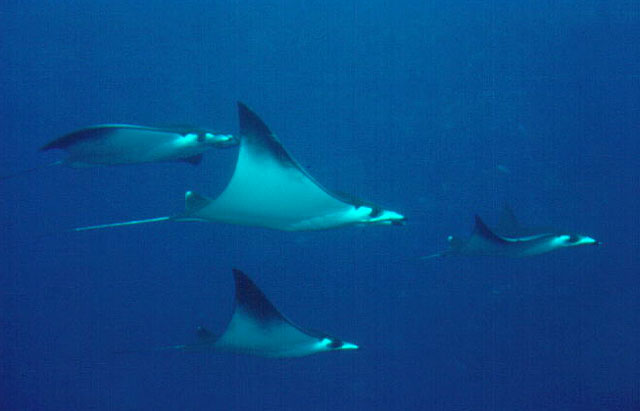Mobula thurstoni
(Lloyd, 1908)
Smooth-tail mobula
Classification: Elasmobranchii Myliobatiformes Mobulidae
Reference of the original description
On two new species of eagle-rays (Myliobatidae), with notes on the skull of the genus Ceratoptera. Records of the Indian Museum, 2(2), 175–180
On two new species of eagle-rays (Myliobatidae), with notes on the skull of the genus Ceratoptera. Records of the Indian Museum, 2(2), 175–180
Synonyms / new combinations and misspellings
Dicerobatis thurstoni, Mobula lucasana
Dicerobatis thurstoni, Mobula lucasana
Types
Mobula thurstoni
Syntype: Gov. Mus. Chennai: (whereabouts unknown)
Mobula lucasana
Holotype: AMNH: 15675 (ex NYZS 24793); AMNH: 15676 (ex NYZS 24793);
Mobula thurstoni
Syntype: Gov. Mus. Chennai: (whereabouts unknown)
Mobula lucasana
Holotype: AMNH: 15675 (ex NYZS 24793); AMNH: 15676 (ex NYZS 24793);
Description :
Citation: Mobula thurstoni (Lloyd, 1908): In: Database of modern sharks, rays and chimaeras, www.shark-references.com, World Wide Web electronic publication, Version 01/2026
Please send your images of "Mobula thurstoni" to info@shark-references.com

Mobula thurstoni (Lloyd, 1908), ©Randall, J.E, www.fish-base.org

Mobula thurstoni (Lloyd, 1908), ©Randall, J.E, www.fish-base.org
Common names
 Chupa sangre,
Chupa sangre,  Chupasangre,
Chupasangre,  Diablo,
Diablo,  Diablo chupasangre,
Diablo chupasangre,  Diablo manta,
Diablo manta,  Manta,
Manta,  Manta diablo,
Manta diablo,  Manta doblada,
Manta doblada,  Manta raya,
Manta raya,  Murciélago,
Murciélago,  Mante vampire,
Mante vampire,  Bentfin devil ray,
Bentfin devil ray,  Bentfin devilray,
Bentfin devilray,  Lesser devil ray,
Lesser devil ray,  Manta,
Manta,  Smooth tail devil ray,
Smooth tail devil ray,  Smooth-tail mobula,
Smooth-tail mobula,  Smoothtail mobula
Smoothtail mobula
 Chupa sangre,
Chupa sangre,  Chupasangre,
Chupasangre,  Diablo,
Diablo,  Diablo chupasangre,
Diablo chupasangre,  Diablo manta,
Diablo manta,  Manta,
Manta,  Manta diablo,
Manta diablo,  Manta doblada,
Manta doblada,  Manta raya,
Manta raya,  Murciélago,
Murciélago,  Mante vampire,
Mante vampire,  Bentfin devil ray,
Bentfin devil ray,  Bentfin devilray,
Bentfin devilray,  Lesser devil ray,
Lesser devil ray,  Manta,
Manta,  Smooth tail devil ray,
Smooth tail devil ray,  Smooth-tail mobula,
Smooth-tail mobula,  Smoothtail mobula
Smoothtail mobula
Short Description
A moderate-sized devilray with a short head bearing short head fins; dorsal fin white-tipped, and pectoral fins with swept-back tips and a prominent double bend to the front margins; upper disc sparsely covered with small, blunt denticles and tail shorter than disc, with no spine [536]. Dark blue to black above; white below, with silvery pectoral fin tips [536]. No caudal fin [536].
A moderate-sized devilray with a short head bearing short head fins; dorsal fin white-tipped, and pectoral fins with swept-back tips and a prominent double bend to the front margins; upper disc sparsely covered with small, blunt denticles and tail shorter than disc, with no spine [536]. Dark blue to black above; white below, with silvery pectoral fin tips [536]. No caudal fin [536].
Distribution
Probably circumtropical but in scattered localities. Eastern Atlantic: off Senegal and Côte d"quot;Ivoire. Indian Ocean: off South Africa, Bay of Bengal, and probably Indonesia (Ref. 9911). Western Pacific: Gulf of Thailand (Ref. 9911) and northeastern Australia [1388]. Eastern Pacific: southern California, USA to Costa Rica [17050], including the Gulf of Tehuantepec (Ref. 9911). Reported from Chile (Ref. 9068). Possibly = Mobula eregoodoo (Cantor, 1849) [529]. Source: www.gbif.org
Probably circumtropical but in scattered localities. Eastern Atlantic: off Senegal and Côte d"quot;Ivoire. Indian Ocean: off South Africa, Bay of Bengal, and probably Indonesia (Ref. 9911). Western Pacific: Gulf of Thailand (Ref. 9911) and northeastern Australia [1388]. Eastern Pacific: southern California, USA to Costa Rica [17050], including the Gulf of Tehuantepec (Ref. 9911). Reported from Chile (Ref. 9068). Possibly = Mobula eregoodoo (Cantor, 1849) [529]. Source: www.gbif.org
Human uses
fisheries: minor commercial; price category: medium; price reliability: very questionable: based on ex-vessel price for species in this family
fisheries: minor commercial; price category: medium; price reliability: very questionable: based on ex-vessel price for species in this family
Biology
Exhibit ovoviparity (aplacental viviparity), with embryos feeding initially on yolk, then receiving additional nourishment from the mother by indirect absorption of uterine fluid enriched with mucus, fat or protein through specialised structures [733]. With one large offspring per gestation period. Size at birth 65-85 cm [1388]. Occurs in coastal and oceanic waters, but more common near the coast. Found singly or in small groups. Feeds mainly on planktonic crustaceans.
Exhibit ovoviparity (aplacental viviparity), with embryos feeding initially on yolk, then receiving additional nourishment from the mother by indirect absorption of uterine fluid enriched with mucus, fat or protein through specialised structures [733]. With one large offspring per gestation period. Size at birth 65-85 cm [1388]. Occurs in coastal and oceanic waters, but more common near the coast. Found singly or in small groups. Feeds mainly on planktonic crustaceans.
Remarks
shark-references Species-ID=3767; CITES: (see: Protected Species for more details) Convention on International Trade in Endangered Speciesof Wild Fauna and Flora annex: II; Council Regulation 2017/160 annex: B
shark-references Species-ID=3767; CITES: (see: Protected Species for more details) Convention on International Trade in Endangered Speciesof Wild Fauna and Flora annex: II; Council Regulation 2017/160 annex: B
Parasites (arranged by Jürgen Pollerspöck)
Cestoda
Trematoda
Copepoda
Cestoda
- Archaenybelina mimicricestus Suryaningtyas, Neitemeier-Duventester, Damriyasa, Frank, Haseli & Palm, 2024 [33723]
- Archaenybelina pseudotetrabothrialis Suryaningtyas, Neitemeier-Duventester, Damriyasa, Frank, Haseli & Palm, 2024 [33723]
- Hemionchos striatus Campbell & Beveridge, 2006 [9451] [23771]
- Mobulocestus lepidoscolex Campbell & Beveridge, 2006 [9451] [23771]
- Mobulocestus mollis Campbell & Beveridge, 2006 [9451] [23771]
- Mobulocestus nephritidis Campbell & Beveridge, 2006 [9451] [23771]
Trematoda
- Nagmia cisloi Curran, Blend & Overstreet, 2009 [16108] [23771]
- Syncoelium vermilionense Curran & Overstreet, 2000 [23771]
Copepoda
- Echthrogaleus disciarai Benz & Deets, 1987 [15947]
- Entepherus laminipes Bere, 1936 [15950]
- Eudactylina oliveri Laubier, 1968 [17867]
- Kroeyerina mobulae Deets, 1987 [15948]

















